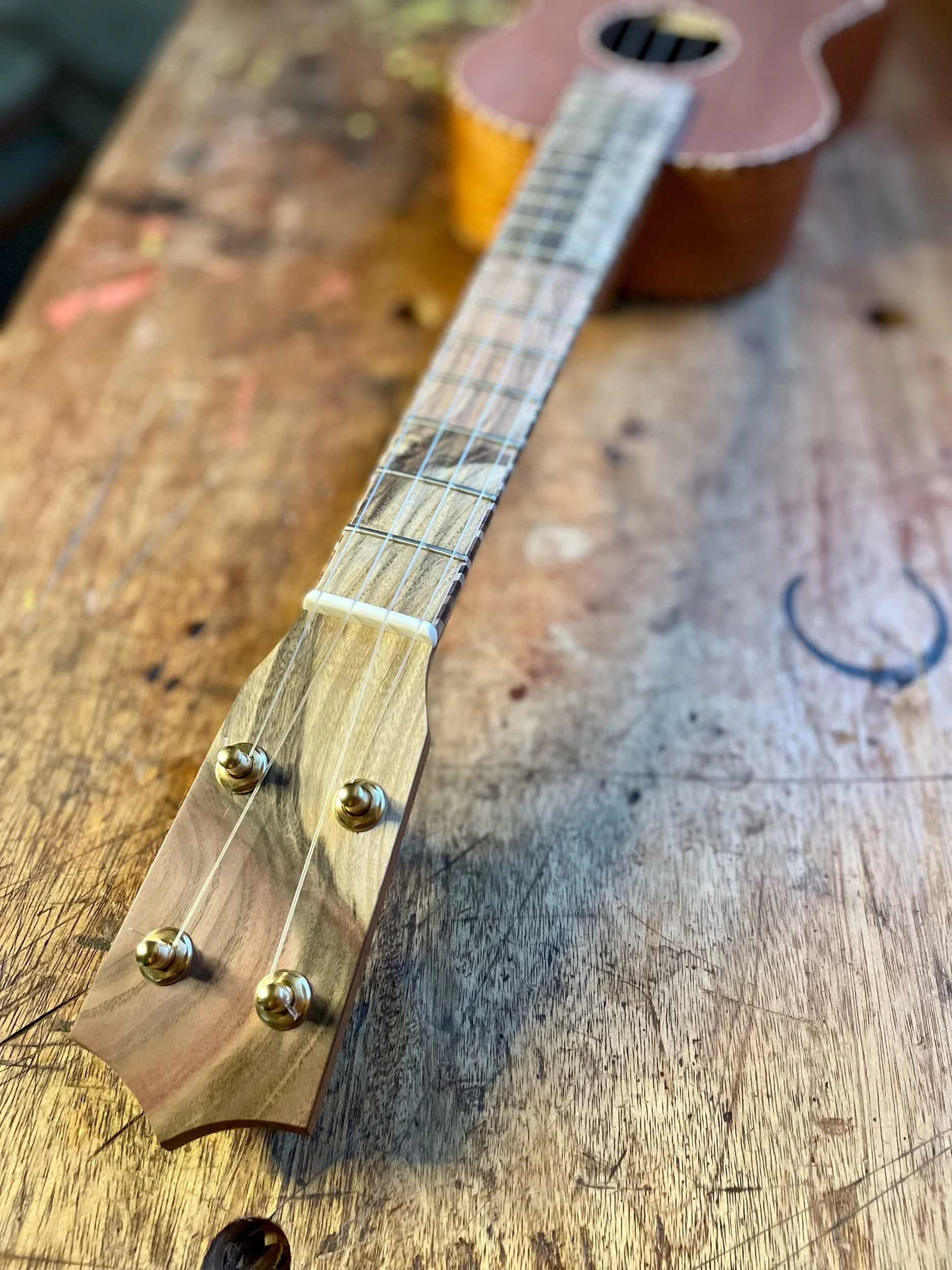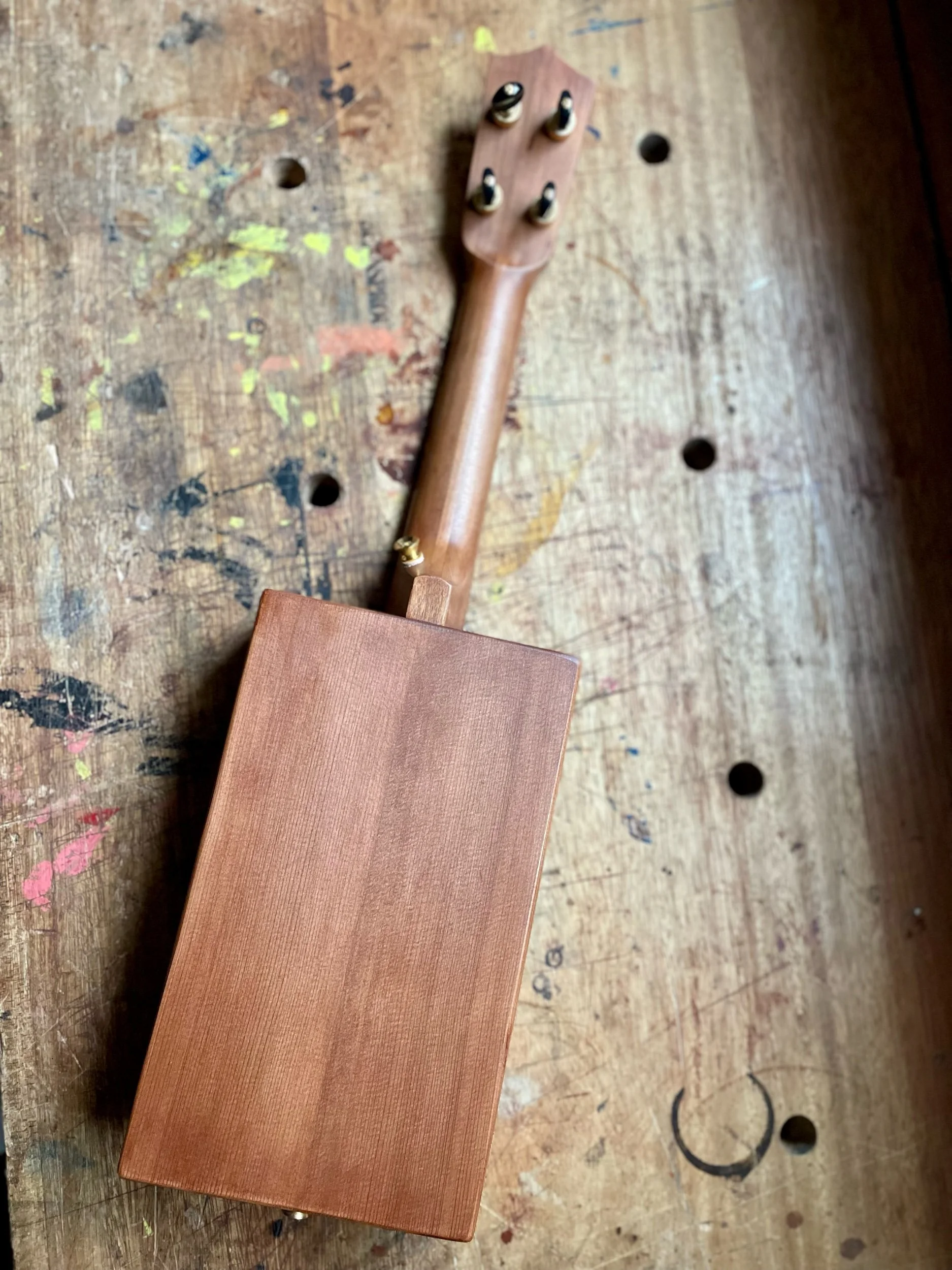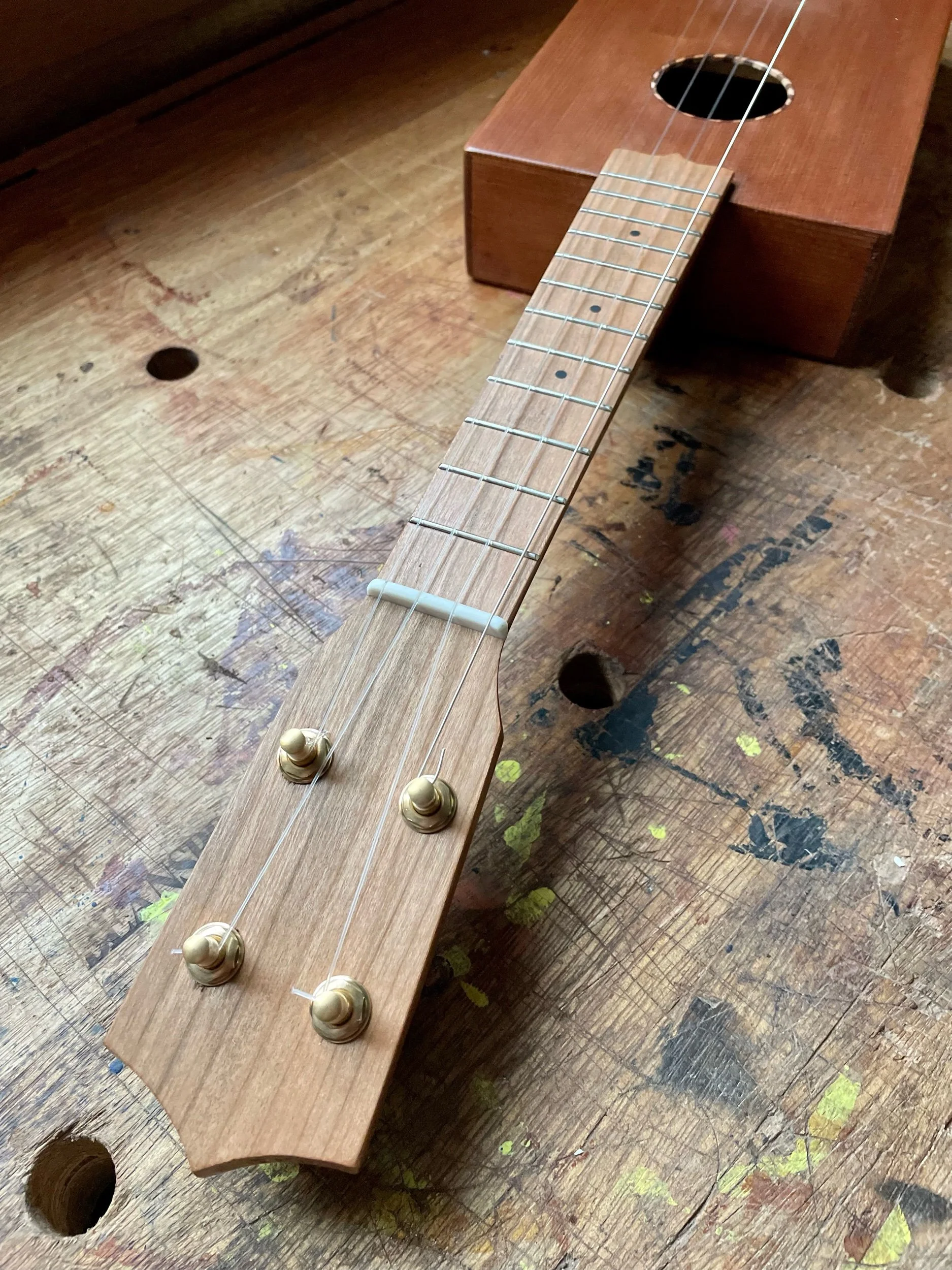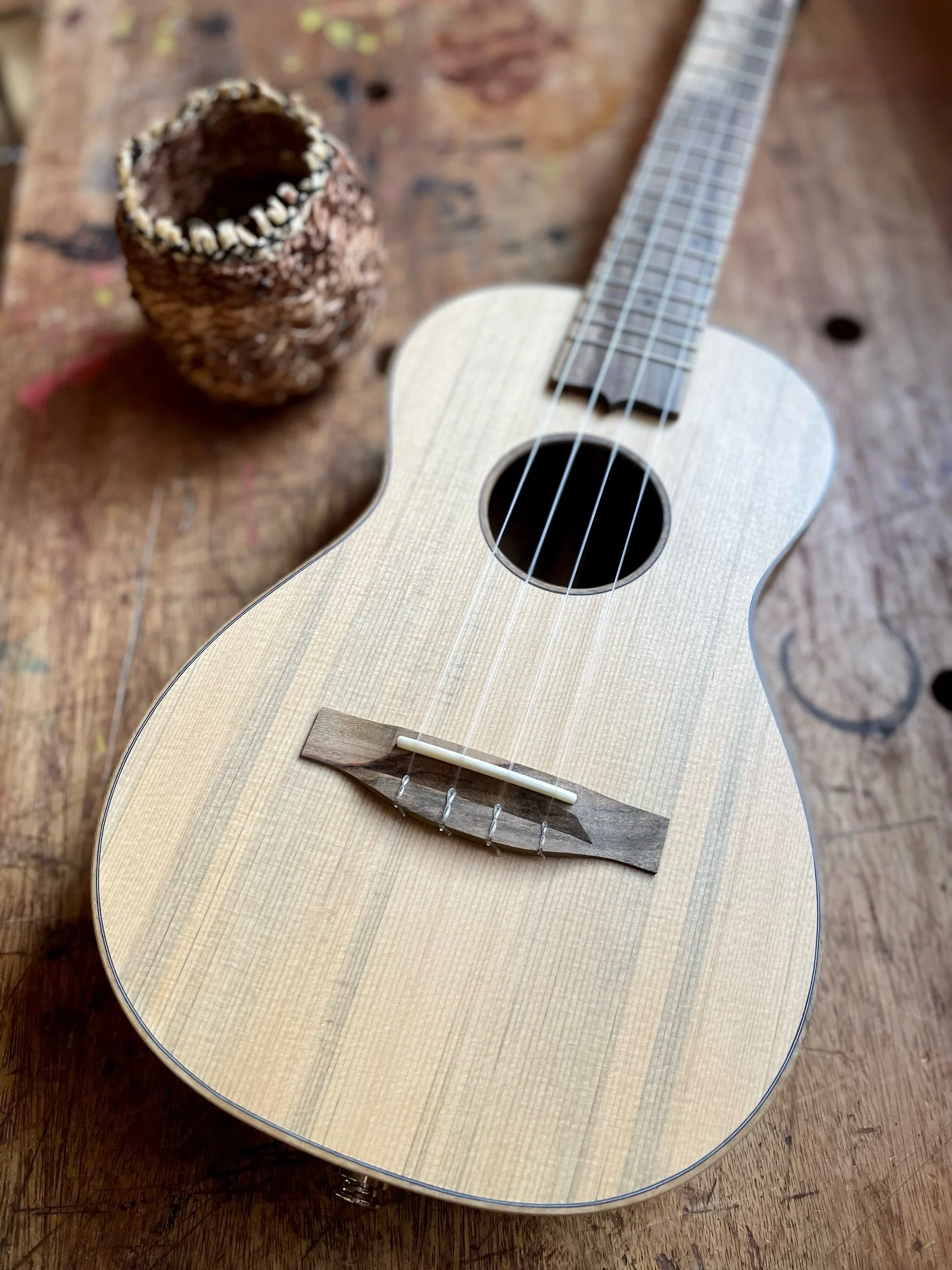Kevin from woodfromthewest.com has been telling me about this Walnut tree they took down near Medford, OR. It’s been drying for years and I finally dug into for this banjo. It looks awesome and the sound is just what I want. Dark and rich but also loud and expressive. I’m really impressed. This customer wanted a 12” rim with goat skin head, brass tone ring, steel strings and an arm rest. All around a great design that I am having fun playing. I complimented the walnut with some grafted Pistachio from California orchards, also from Kevin.
#770- Spruce and Mahogany Tenor Guitar
This is my third tenor guitar based on the old Regal pattern. It’s bigger than a baritone uke, but still appropriate for a four string instrument. It’s got ladder bracing, steel strings, a tailpiece and a floating bridge. It’s punchy, sweet and sings with a nice sustain. The Sitka Spruce top and neck are from Vancouver Island. The Mahogany back and sides were salvaged from a Tacoma boat shop. The Walnut fretboard, headplate and binding are from a tree in Hood River. It has geared Gotoh tuners, a K&K pickup and a rustic star inlaid on the fretboard.
#769- Redwood and Curly Walnut Tenor Ukulele
This uke is for Steve Varney, one of our long term artists. I’ve only built banjos for him before, this is the first uke. All the Walnut is from The Dee Mill, right down the road from us. The Redwood top is a scrap from a guitar maker. It has a couple of natural flaws, but I’m happy to repair them and use it. We all have a few natural flaws. The Mahogany neck is salvaged from a Tacoma boat shop. Redwood and Walnut has a rich and thoughtful sound, with just enough brightness to cut through the mix. I’ve made several this way and I’m happy to do more of it.
#773- Curly Port Orford Cedar and Dogwood Alto Ukulele
Everything on this uke is wavy, curly, funky and wild looking. It makes for a fun project, with all the curves and angles working together to make a complete look. The top and neck are curly Port Orford Cedar from the Oregon coast, via woodfromthewest.com. The rest of the instrument is Dogwood, from a tree that Ken from the Carpenter Ant stash harvested from their yard in Portland many years ago. It features a headstock shape from an instrument made by Santo in the 1880’s, wooden strap buttons and no binding or rosette.
#772- Red Oak Scout Banjo Ukulele
I’ve recently started applying a new approach to my banjo designs in order to make a lighter weight, more traditional and lower cost instrument. They are generally made of scraps or less fancy wood, have less brass hardware and use thinner steam bent rims. In this case, I used some red oak from the Carpenter Ant stash, some Pistachio from California Orchards and some walnut scraps. I’m not sure I am ready to do this with every banjo, but it’s a path I’m interested in exploring.
“Just wanted to drop you a line to say that my banjo uke arrived safe and sound and is absolutely a masterpiece. I love the old timey sound and the fact that it was built from mostly scraps gives it so much character. I hope you make more of these. It is amazing.
I have been a huge fan of your work (both music and luthier) for a long time and am happy I finally got a beansprout uke banjo.
Kind regards,
- A. R. ”
#771- Yellow Cedar and Walnut Soprano Ukulele
This is for our longtime customer, Jennifer. The Walnut is from a piece of furniture her dad built many years ago, but was no longer functional. I used it for the back, sides, fretboard, headplate and bridge, and boy is it beautiful! The top is some Yellow Cedar I salvaged from my neighbor’s shop and the neck is salvaged Cypress from an old factory. The rope sound hole binding and endgraft are some classy details to pull it all together.
“This is the soprano of my dreams! This little ukulele truly has it all - the featherweight lightness of a vintage soprano but the playability and functionality that those vintage sopranos lack. The sound is amazing as it has all the sparkle and charm that is expected of a soprano, but also sustain and a maturity and depth that is uncommon in sopranos. I am so pleased you decided to offer sopranos since it is rare to find a luthier who will make them at all, let alone make such fantastic sopranos. You have mentioned the challenge of building for a repeat customer and you absolutely achieved that with this ukulele because you couldn’t have pleased me more. I wish my dad could see what the walnut he purchased for his high school woodshop project became … I know he would have loved it. Thank you for taking on this project and giving me a reminder of him I can hold every day and use to bring music into the world.
- J. L. ”
#766- Yellow Cedar and Myrtle Scout Ukulele
This one was fun! It looks classy and is dark and rich for such a little guy. It’s a soprano scale ukulele made from shop scraps. Yellow Cedar neck and top, Curly Myrtle back and sides, Texas Ebony for the rest. It’s off to the scout list. Cheers!
“Hi Nicole and Aaron . . . I just wanted to let you know that I bonded immediately with ‘Myrtle’ #766, right out of her case! She is such a pleasure to play with and
her wood is exquisite as is her smooth satiny finish. I fully appreciate the deeper sound of this particular soprano. I knew I just needed to wait and be patient for the perfect Scout to come my way—and here she is!
Thank you for your lightening fast transaction and shipping! Aaron, your meticulous attention to detail, design and all around sense of aesthetics is quite evident in your work . . .
We’ve gotten a daily workout since the moment she arrived!
Many thanks for your beautiful creation and craftsmanship!
Play on,
J. K. ”
#767- Redwood and Mahogany Tenor Ukulele
This is instrument is mainly made from wood I salvaged from a closing boat shop in Tacoma, WA. I heard about some very old, very large pieces of real Honduras Mahogany that was there. I teamed up with a few guitar builders to split the stash, and found a plank of mahogany 10 feet by 4 feet by 4 inches. Behind was another plank half that size and behind that was this amazing redwood piece. I made a deal for all of it, managed to get it in my truck and got out of there before anyone could stop me. This sort of Mahogany is prized by luthiers for its strength to weight ratio, easy workability and beautiful grain. The Redwood is also nice, super old, super tight grained and perfectly quartersawn. Look forward to a lot of both of these boards over the next several years. I chose to pair it with some amazing grafted Pistachio from California orchards and my shop made rope binding.
#762- Spruce and Walnut Tenor Ukulele
A rustic look with simple domestic woods. Rich tone with a bit of a sparkle to it. I’m really proud of this one. The Spruce top is the last of my salvaged dulcimer maker’s Spruce from the 1960’s. The back and sides are local Oregon Walnut from the Dee Mill, the same board as Dave Matthews’s ukes. The Pistachio is from California orchards. Radiused fretboard, geared tuners, fluorocarbon strings, bone nut and saddle.
#758- Cedar Cigar Box Style Ukulele
Why? I don’t know. I just felt like it. It turns out that it sounds pretty darn good, with a dry and present voice. Cigar box instruments are an old part of American folk art, Sam Kamaka Jr even made some in the 1940-50’s. Instead of an actual cigar box, I used salvaged western red cedar throughout, with some cherry and maple for the hardwoods. It is concert scale, with a flat fret board, geared tuners, bone nut and saddle, brass strap buttons and fluorocarbon strings.
#765- Mastergrade Myrtle Tenor Ukulele
This summer, we made a builder’s choice baritone ukulele where Nicole picked everything out. That customer loved it and asked for a matching tenor version. The top/back/sides are Mastergrade Myrtle; colorful, curly and laid out with one piece top and back for an asymmetrical look. The neck is salvaged old growth Douglas Fir with a maple stripe. The fretboard is some grafted pistachio from California orchards. The headplate, bridge and binding are figured maple, with an inlaid scrap wood star. It’s fancy and I’m proud of it. The Myrtle and Pistachio are from www.woodfromthewest.com.
“I have been playing either the new baritone, the new tenor, or both every day. I love them both. They have definitely become my two “go to” ukuleles. I asked if you could make the tenor as much like the baritone as possible, and you did a wonderful job with that. They definitely look like siblings.
They are both beautiful, and the quality work is clearly evident in every detail on both ukuleles. The quality doesn’t end, though, with the look of the ukuleles. They are both very playable. The necks are very comfortable, and they are both very light and balanced, so they are very comfortable to play. The tone and intonation up the neck is better than any of my other ukuleles.
As a result, I am now exploring playing on the higher frets. The baritone has a beautiful warm tone; the tone of the tenor is much brighter. The contrast in tone between the two ukuleles give me two wonderful options to create the sound I want for each song. I know I will be playing both of these ukuleles for many years. I also love the hard cases that came with them, especially the tweed case for the tenor. Finally, I greatly appreciate that you use sustainably sourced woods from the United States.
Thanks again for these two wonderful instruments!
-H. L. ”
#763- Cedar and Dogwood Baritone Ukulele
This is instrument is one of a handful now that was inspired by Lizann’s original Cedar and Dogwood baritone. I think we have made four now?!? Every piece on it is salvaged, which sounds fun, but can sometimes mean extra work, but it’s worth it! The Cedar top is from a fence post from Duncan and Melany’s property on Cascade Head. It’s really sweet old growth Western Red Cedar, which is highly rot resistant and still useable after 60 years in the weather. The back, sides and pickguard are Dogwood, cut by Ken from the Carpenter Ant Stash in Portland from a tree on their property. It is multi colored, swirly grained and a nice hard wood for back and sides. The fretboard, headplate and bridge are Jatoba, a Brazilian hardwood I found as scraps in Ken’s shop. The neck is cypress from a salvaged factory tank, from Chris at The Dee Mill. Some simple maple ties it all together. Just like it’s other Cedar/Dogwood friends, it sounds huge, rich, detailed and expressive. I love it.
#756- Mastergrade Myrtle Tenor Ukulele
When I start with such a fancy set of Myrtle, it’s easy to feel inspired to match the rest of the parts to it. I picked some grafted Pistachio with dramatic grain and a curly Port Orford Cedar neck blank. I think the dark green Myrtle binding was also a good choice. I inlaid a Roman numeral 3 on the headstock, it’s the customer’s lucky number! The Myrtle is from the Oregon coast and the Pistachio from California orchards, via woodfromthewest.com. The Port Orford Cedar is salvaged from my neighbor’s shop, a retired flute maker.
#764- Spruce and Walnut Tenor Ukulele
This is one of my standard/classic designs and it doesn’t disappoint. Sitka Spruce is very strong but lightweight, which makes for a loud and responsive instrument. The Spruce top is from my dulcimer maker’s stash, cut in the 1960’s for a dulcimer maker who never used it. The Oregon Walnut back and sides is local, from The Dee Mill and is the same board that I used for all of Dave Matthew’s ukuleles. The neck is some Spruce from Craig Wilson’s shop, too small to be one of his guitars, but good for this project. The subtle but colorful Pistachio is perfect for the fretboard and headplate, salvaged from California orchards.
#761- Mahogany Alto Ukulele
This African Mahogany (Sapele, I think) was bought by me from a Luthier’s estate about 12 years ago. Including my time at Mya-Moe, I guess about 50 ukes have come from this pile. It feels safe and comfortable to me, which is why I grabbed it for this project. A simple alto uke with a low g. Rich but punchy. The walnut pieces are from a local tree that I milled. The rope binding adds a flashy but traditional flair.
“Hey Nicole and Aaron!
Just wanted to let you know that I’ve been really enjoying the instrument. Actually that would be an understatement.
I am completely in love : )
Thank you so much for what you do, and I wish you a warm, happy, healthy, and prosperous new year!
- A. L.
”
#759- Redwood and Walnut Scout Ukulele
This instrument design is humble. It is inspired by the camp ukulele made by Lyon and Healy in the early 20th century. I make them from shop scraps when I find the time. I never really expected anyone to like them, but now I have about a year’s worth of people waiting for one. Their sound is also humble, but don’t be fooled, there is a lot of music hiding in there. Redwood top, Walnut back/sides/fretboard/headplate/bridge, Oak binding and Fir neck.
#760- Curly Maple Five String Banjo
I have spent years stockpiling nice maple to use for banjos, but customers rarely ask for it. Maybe they already have a maple banjo and are ordering from me to get a less common wood. I’m always happy to use it, though. I like the look, the feel and the tone. In this case, the non steel strings combine with the maple for a crisp but mellow tone with a round sustain. The maple is from the Carpenter Ant stash in Portland and the Pistachio is from California Orchards.
#751- Mahogany Tenor Ukulele
None of us are perfect, but we all matter and we’ve got some life left in us, I think. This simple tenor Uke is made from all salvaged scraps from the shop. The body is African Mahogany, cast off because the pieces were too small for guitar makers. The Fir neck and Maple everything else are scraps from the Carpenter Ant stash in Portland. I added some rustic stain to pop the grain, which I really like. It’s got a low g, geared tuners, brass strap buttons, a radiused fretboard and bone nut and saddle. Easy to play, with a big, honest sound.
#752- Blue Stained Port Orford Cedar and Mastergrade Myrtle Tenor Ukulele
It’s my bread and butter, so keep asking for them and I’ll keep making them! Port Orford Cedar and Myrtle are both Oregon woods that we are really proud of. They look great and sound great too. Lightweight but robust, loud but rich, detailed and expressive. Some Pistachio from California Orchards complete the picture. All the wood for this instrument comes from Kevin at woodfromthewest.com.
“#752 is a delight to play and to look at. I love the choice of the myrtle binding. The Baroque and Renaissance period pieces that I play sound fantastic. Thank you again for such a wonderful instrument that I will cherish and play for years to come.
- G. O. ”
#755- Myrtle and Walnut Concert Banjo Ukulele
Myrtle is a medium density hardwood that comes from Oregon. It is very useful in my shop, it even is good for banjos! This tree came from a Portland home, courtesy of Epilogue, an urban forestry mill. I love all the different shades of green, which contrasts with the darker Walnut. The Walnut for this build comes from the scrap bin at Goby, also in Portland. A goatskin head, white fret dots, brass arm rest and a low g make it more unique and personal. I love how loud it sounds, despite the lighter weight of the Myrtle.








































































































































